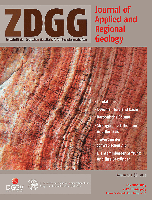
Zeitschrift der Deutschen Gesellschaft fur Geowissenschaften
Scope & Guideline
Connecting Scholars: Insights into Planetary Science and Environment
Introduction
Aims and Scopes
- Geological Stratigraphy and Sedimentology:
The journal emphasizes the study of stratigraphic sequences, sedimentary environments, and facies development across various geological timeframes, particularly focusing on the Central European region. - Geological History and Paleogeography:
Research articles often explore historical geological events, paleogeographic reconstructions, and their implications for current geological understanding and resource management. - Geotechnical Engineering and Environmental Geoscience:
The ZDGG publishes studies addressing geotechnical challenges, including soil stability, natural hazards, and the impact of anthropogenic activities on geological formations. - Geochemistry and Mineralogy:
The journal includes research on the geochemical properties of various geological formations and mineral deposits, contributing to the understanding of resource potential and environmental impact. - Historical Geology and Institutional Development:
A unique contribution of the journal is its focus on the historical development of geology and geoscience institutions, documenting the evolution of geological understanding in Germany. - Geological Mapping and Resource Assessment:
The ZDGG supports studies that advance geological mapping techniques and resource assessment methodologies, promoting sustainable resource management.
Trending and Emerging
- Carbon Capture and Storage (CCS):
Recent publications have increasingly addressed the topic of carbon capture and geological storage, reflecting the global focus on climate change mitigation and sustainable energy practices. - Geothermal Energy Exploration:
There is a growing emphasis on the exploration and utilization of geothermal energy resources, particularly in relation to deep geological formations, highlighting the journal's response to the energy transition. - Natural Hazard Assessment and Mitigation:
Research focusing on the assessment and modeling of natural hazards, such as landslides and flooding, is on the rise, indicating a heightened awareness of climate-related risks and the need for effective management strategies. - Geosynthetics and Engineering Solutions:
Innovative approaches using geosynthetics in engineering applications, particularly in soil stabilization and slope stability, have gained traction, showcasing advancements in geotechnical engineering. - Interdisciplinary Approaches to Geoscience:
There is an emerging trend towards interdisciplinary studies that combine geology with other scientific fields, such as hydrology, environmental science, and engineering, reflecting the complex nature of contemporary geological challenges.
Declining or Waning
- Anthropogenic Environmental Impact Studies:
Although previously a significant area of focus, studies specifically addressing the impacts of human activity on geological processes have decreased, possibly due to a broader integration of these concerns into other research themes. - Historical Geology of Non-European Regions:
Research articles examining historical geology outside of Europe, particularly those focusing on non-Western geological contexts, have become less frequent, possibly as the journal prioritizes more regionally relevant studies. - Geological Education and Outreach:
Papers dedicated to geoscience education and public outreach have waned, indicating a potential shift towards more research-intensive articles rather than pedagogical approaches. - Paleontology:
While still present, the frequency of paleontological studies has diminished, reflecting a broader trend towards geochemistry and sedimentology over traditional paleontological research.
Similar Journals

DOKLADY EARTH SCIENCES
Advancing Knowledge in Earth and Planetary SciencesDOKLADY EARTH SCIENCES is a reputable journal published by MAIK NAUKA/INTERPERIODICA/SPRINGER, focusing on the dynamic field of Earth and Planetary Sciences. With an ISSN of 1028-334X and E-ISSN 1531-8354, this journal offers a platform for researchers to disseminate their findings and insights that contribute to our understanding of Earth systems over a continuous publishing span from 1998 to 2024. It currently holds a Q3 quartile ranking in the Earth and Planetary Sciences category, reflecting an emerging yet significant impact within its field, evidenced by its Scopus ranks where it stands at 123rd in general Earth sciences and 113th in miscellaneous Earth sciences. DOKLADY EARTH SCIENCES aims to bridge research gaps and foster collaboration among a diverse audience including researchers, professionals, and students committed to advancing knowledge in geoscience. The journal stands as a vital resource for those seeking to explore contemporary challenges and innovations within the realm of Earth sciences.

Journal of Himalayan Earth Sciences
Advancing Knowledge in Himalayan Earth SciencesThe Journal of Himalayan Earth Sciences (ISSN: 1994-3237; E-ISSN: 2305-6959) is a distinguished publication by UNIV PESHAWAR, dedicated to advancing knowledge in the field of earth sciences, particularly as they relate to the Himalayan region. Established in 2013, this journal aims to provide a platform for researchers, professionals, and students to share original research findings, reviews, and innovative methodologies that contribute to the understanding of geological and environmental phenomena in this ecologically significant area. Despite being categorized in Q4 of the Earth and Planetary Sciences, the journal showcases valuable contributions to the scientific community and encourages submissions that delve into both the challenges and advancements within Earth sciences, with a particular focus on the unique geological structures and processes of the Himalayas. As an open-access journal, it ensures that research is accessible to a global readership, promoting collaboration and discussion among scholars and practitioners. The journal's operational base in Peshawar, Pakistan, places it at the heart of Himalayan research, making it an invaluable resource for those invested in earth sciences.

GEOLOGICAL QUARTERLY
Connecting Minds in Earth Sciences Since 2000.GEOLOGICAL QUARTERLY, published by the Polish Geological Institute, is a respected journal in the field of geology, offering insights into Earth and planetary sciences since its inception in 2000. With an ISSN of 1641-7291 and an E-ISSN of 2082-5099, this journal serves as a vital platform for researchers, professionals, and students seeking to expand their knowledge in geological disciplines. The journal is positioned in Q3 within the geology category as of 2023 and ranks #172 out of 321 in Scopus, placing it in the 46th percentile among its peers. Although currently not an open-access publication, GEOLOGICAL QUARTERLY reflects the policy of fostering scientific communication and collaboration by disseminating valuable geological research. Its commitment to publishing original articles, reviews, and technical notes ensures that it plays a significant role in advancing geological science and its applications within the academic community. With its base in Warsaw, Poland, the journal stands as an important resource for anyone engaged in or studying the Earth sciences.
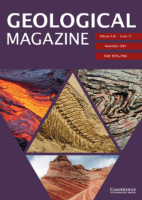
GEOLOGICAL MAGAZINE
Connecting Scholars to the Heart of GeologyGEOLOGICAL MAGAZINE, published by Cambridge University Press, is a premier journal in the field of geology, renowned for its rich legacy since 1864 and ongoing contributions to Earth and Planetary Sciences. With an impressive Q1 ranking in Geology and a Scopus rank of #70 out of 321 journals, it holds a significant position within the academic community, appealing to researchers, professionals, and students alike. The journal covers a wide array of topics, ensuring a comprehensive platform for the dissemination of cutting-edge geological research. Although it does not offer open access, it remains a vital resource for those seeking to stay abreast of advancements in the field. With an enduring commitment to quality, GEOLOGICAL MAGAZINE stands as an essential outlet for scholarly communication and serves as a catalyst for academic discourse within the geological sciences.
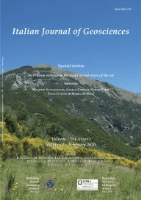
Italian Journal of Geosciences
Connecting Scholars: A Gateway to Earth and Planetary SciencesItalian Journal of Geosciences, published by the Società Geologica Italiana, is a distinguished platform for the dissemination of research in the fields of Earth and Planetary Sciences and Geology. With an impressive impact factor reflected in its 2023 rankings, where it placed in the Q3 category across its related fields, this journal serves as a vital resource for academics, practitioners, and students. Established in 2010 and poised to continue until 2024, the journal showcases critical advancements and interdisciplinary studies that deepen our understanding of geological processes and Earth systems. Operating under open access options, it offers robust accessibility to a broad audience, facilitating wider dissemination of knowledge. The journal's affiliation with Università degli Studi La Sapienza in Rome, Italy, further underscores its commitment to academic excellence and innovation in geosciences.

Journal of Geosciences
Advancing Earth Sciences through Innovative ResearchJournal of Geosciences is a distinguished peer-reviewed journal published by CESKA GEOLOGICKA SPOLECNOST, based in the Czech Republic, that serves as a vital platform for the dissemination of innovative research in the field of Earth and Planetary Sciences. With an ISSN of 1802-6222 and E-ISSN of 1803-1943, this journal has established its significance within the academic community, evidenced by its Q3 ranking in both Earth and Planetary Sciences and Geology. The journal covers a broad array of topics, making it an essential resource for researchers, professionals, and students interested in geoscientific advancements and discoveries. The Journal of Geosciences reflects a commitment to high-quality scholarship, embracing a variety of methodologies and interdisciplinary approaches, and provides open access to its content, thereby encouraging global collaboration and knowledge sharing among geoscientists. With a publication history converging from 2007 to 2024, it continues to be a prominent venue for critical conversations and developments in the ever-evolving field of geosciences.

BULLETIN OF GEOSCIENCES
Transforming Knowledge into Action for a Sustainable FutureBULLETIN OF GEOSCIENCES, published by the prestigious Czech Geological Survey, stands as a pivotal resource in the fields of Earth and Planetary Sciences and Environmental Science. Since its inception in 2003, the journal has been committed to advancing knowledge through high-quality research, currently holding a commendable Q2 ranking in both disciplines. With its focus on diverse and innovative topics, BULLETIN OF GEOSCIENCES provides an essential platform for researchers, professionals, and students aiming to disseminate and access impactful studies. The journal is indexed in Scopus, ranking #78/195 in General Earth and Planetary Sciences and #110/233 in General Environmental Science, reflecting its significant contribution to academia. Publishing from Prague, Czech Republic, this journal invites contributions that illuminate the interactions between geological processes and environmental phenomena, ensuring an inclusive and accessible approach to crucial global issues.
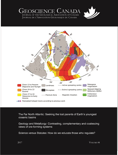
GEOSCIENCE CANADA
Pioneering Research for a Sustainable PlanetGEOSCIENCE CANADA is a premier academic journal published by the Geological Association of Canada, dedicated to advancing knowledge and research in the field of Earth and Planetary Sciences. With an ISSN of 0315-0941 and an E-ISSN of 1911-4850, this journal has been a key platform for scholarly discourse since its inception in 1979, continuing its valuable contributions through to 2024. Positioned in the Q2 quartile for Earth and Planetary Sciences (miscellaneous) as per the 2023 rankings, GEOSCIENCE CANADA is recognized for its rigorous peer-review process and impactful publications, making it a vital resource for researchers, professionals, and students alike. The journal covers a broad array of topics within geoscience, promoting innovative research and discussions pertinent to geologists and Earth scientists across Canada and internationally. While it does not currently provide open access options, the journal continues to support a diverse readership eager to engage with cutting-edge studies that shape the understanding of Earth's processes.

GEOLOGICA BELGICA
Connecting Geoscientists for a Sustainable FutureGEOLOGICA BELGICA is a distinguished open access journal dedicated to advancing the field of Earth and Planetary Sciences, published by Geologica Belgica Luxemburga Scientia & Professionis. With an ISSN of 1374-8505 and E-ISSN of 2034-1954, the journal has been a beacon of knowledge since its establishment in 1998, ensuring the broad accessibility of crucial research findings. Based in Brussels, Belgium, the journal is recognized for its impactful contributions and has achieved a commendable Q2 ranking in the Earth and Planetary Sciences category for 2023. This makes it a vital resource for researchers, professionals, and students alike, encouraging the dissemination of cutting-edge research. Spanning a diverse range of topics within its scope and converging from 2007 to 2024, GEOLOGICA BELGICA remains committed to fostering dialogue and collaboration among earth scientists globally, further enhancing its relevance and influence in this essential field of study.
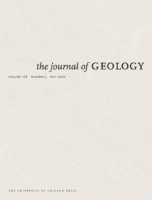
JOURNAL OF GEOLOGY
Advancing Knowledge of Earth's Dynamic Processes.The JOURNAL OF GEOLOGY, published by University of Chicago Press, serves as a premier platform for disseminating groundbreaking research in the field of geology. Established in 1973, this esteemed journal has consistently ranked in the Q2 category in geology, further solidified by its Scopus ranking, where it is positioned at 99 out of 321 in Earth and Planetary Sciences, marking it in the 69th percentile of its category. With an emphasis on innovative and interdisciplinary studies, the journal features peer-reviewed articles that contribute to the understanding of geological processes, earth materials, and environmental interactions. Although it does not currently offer open access, it facilitates broad access through academic institutions to reach a global audience of researchers, professionals, and students striving to advance the knowledge of Earth's history and dynamics. As a vital resource for the geology community, the JOURNAL OF GEOLOGY plays an essential role in fostering scholarly dialogue and advancing both academic inquiry and practical applications in geology.